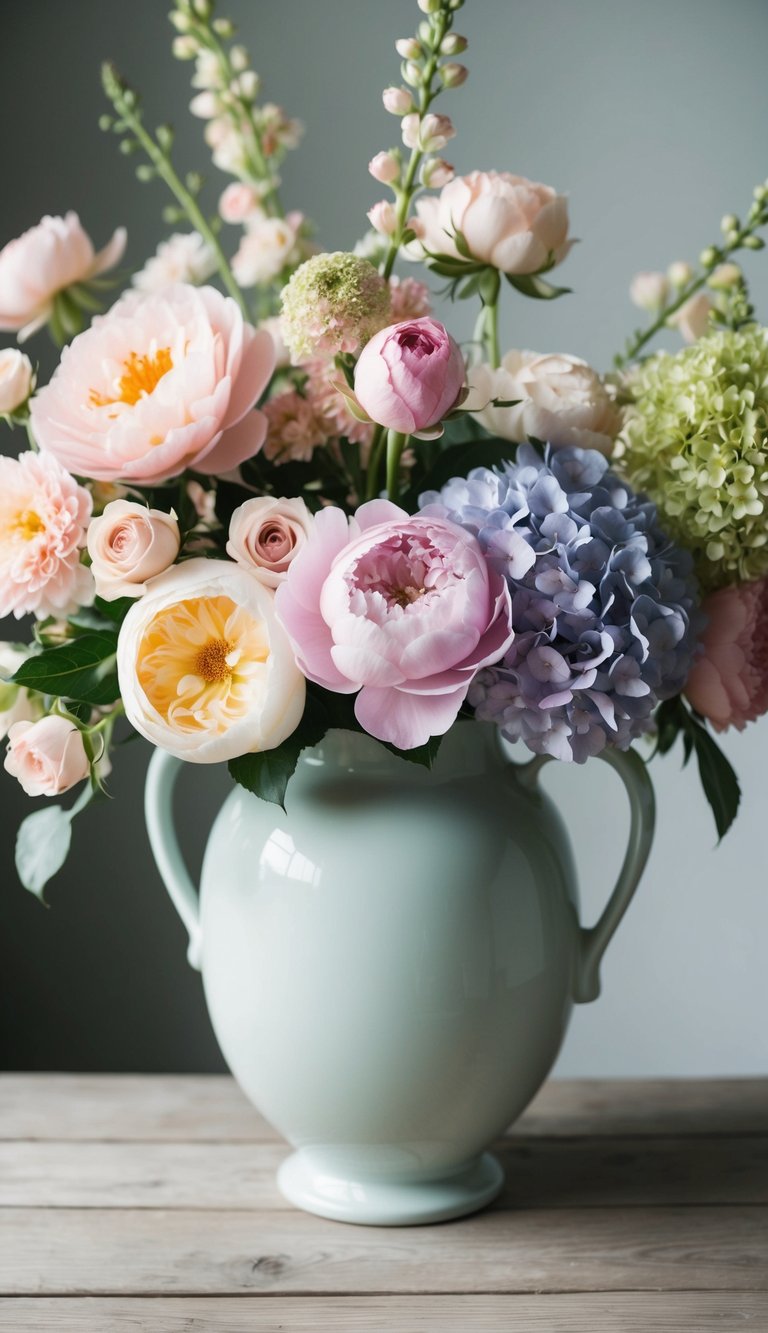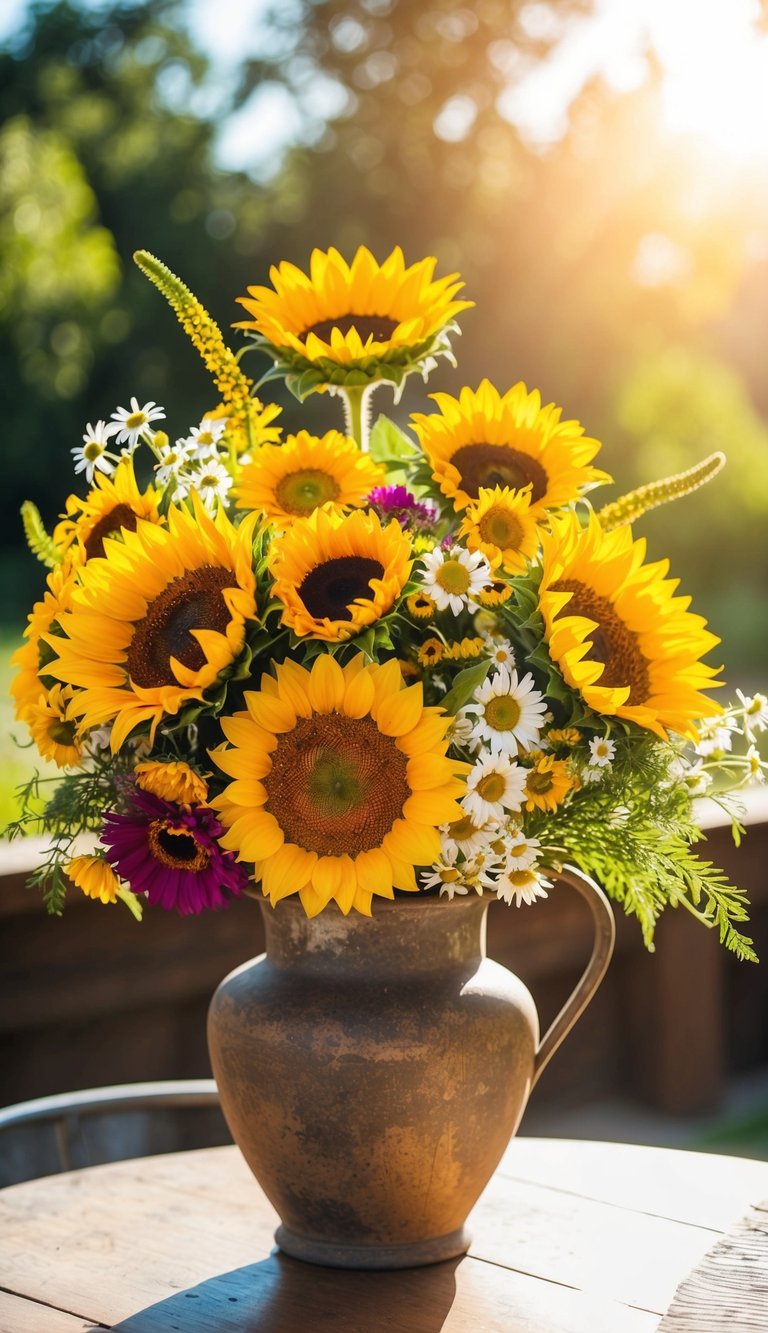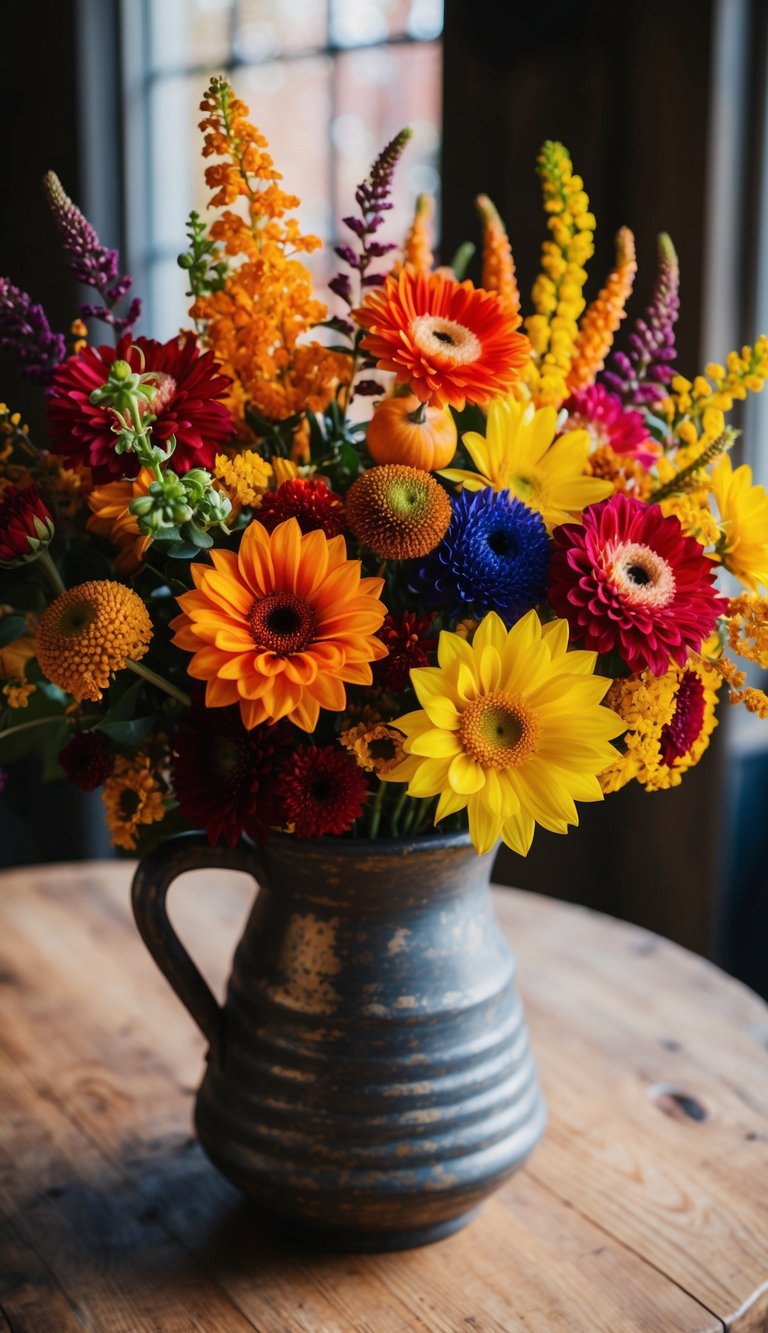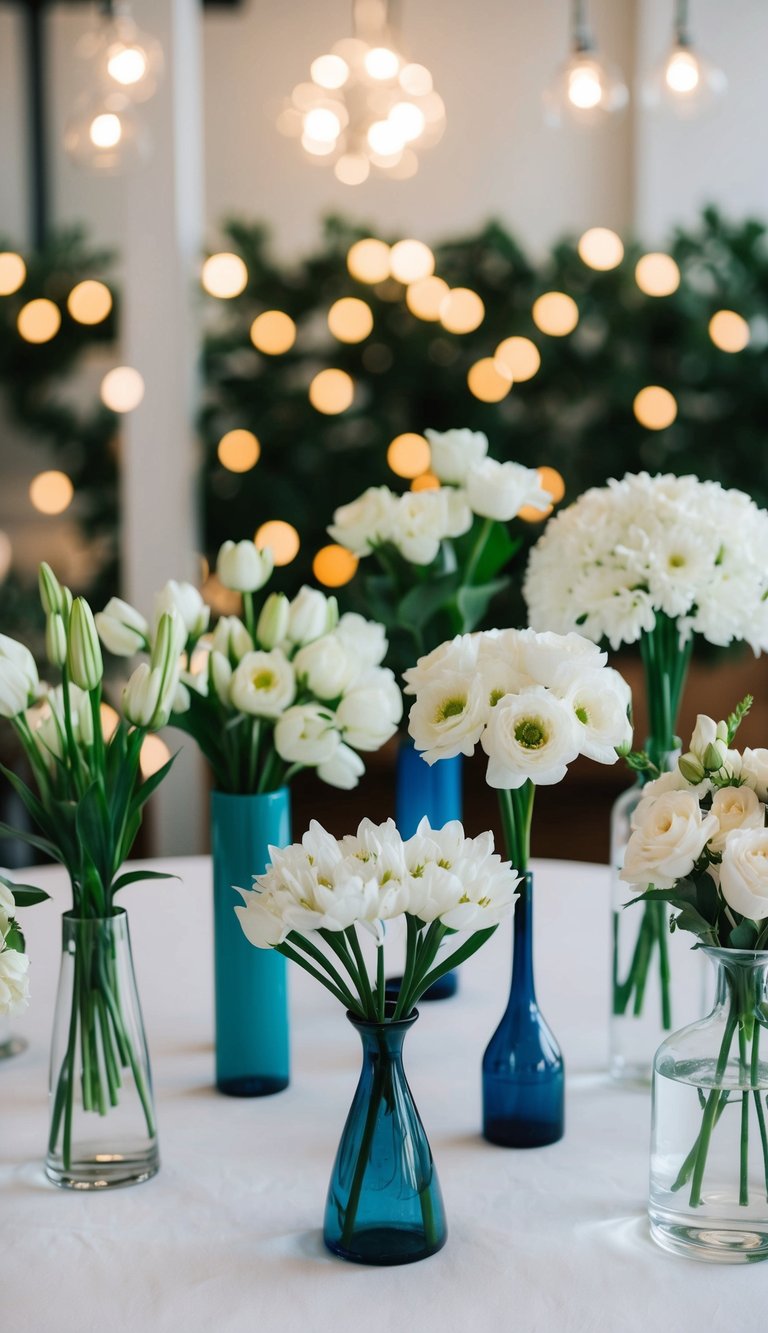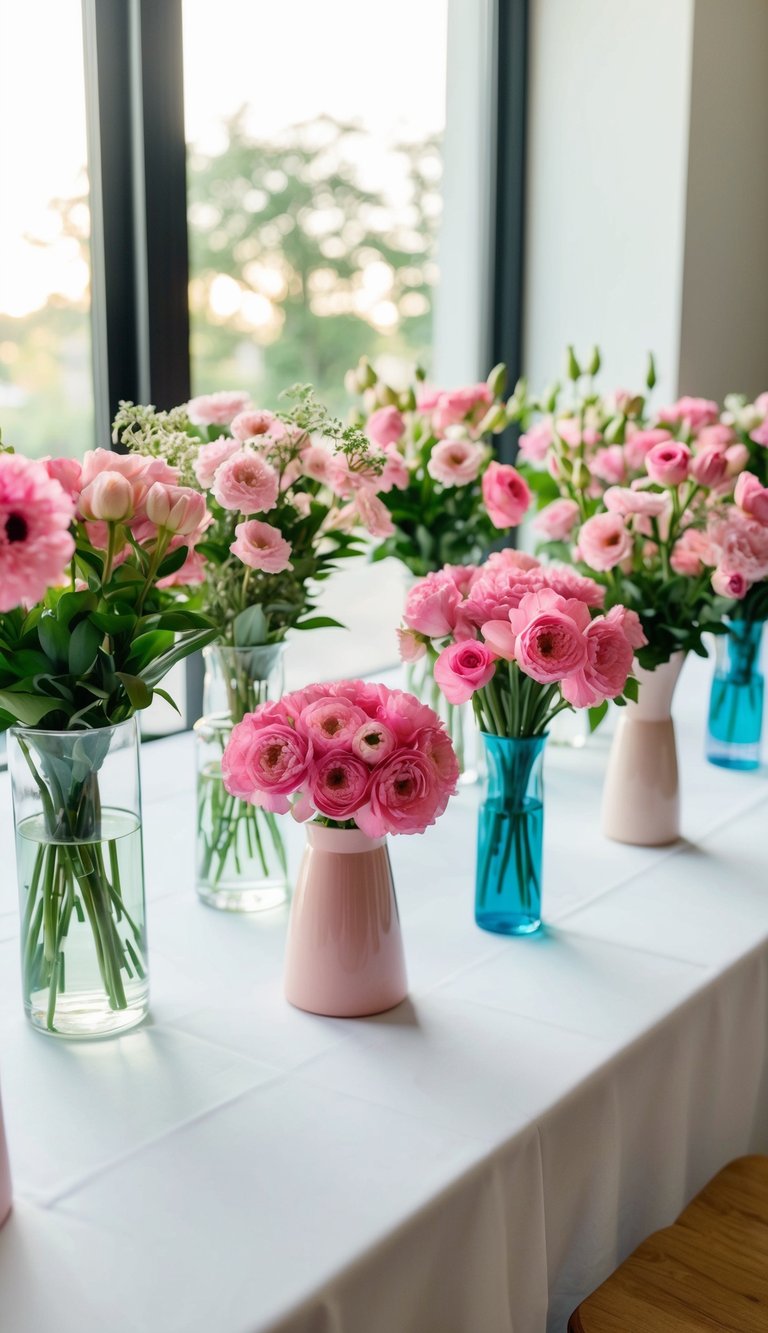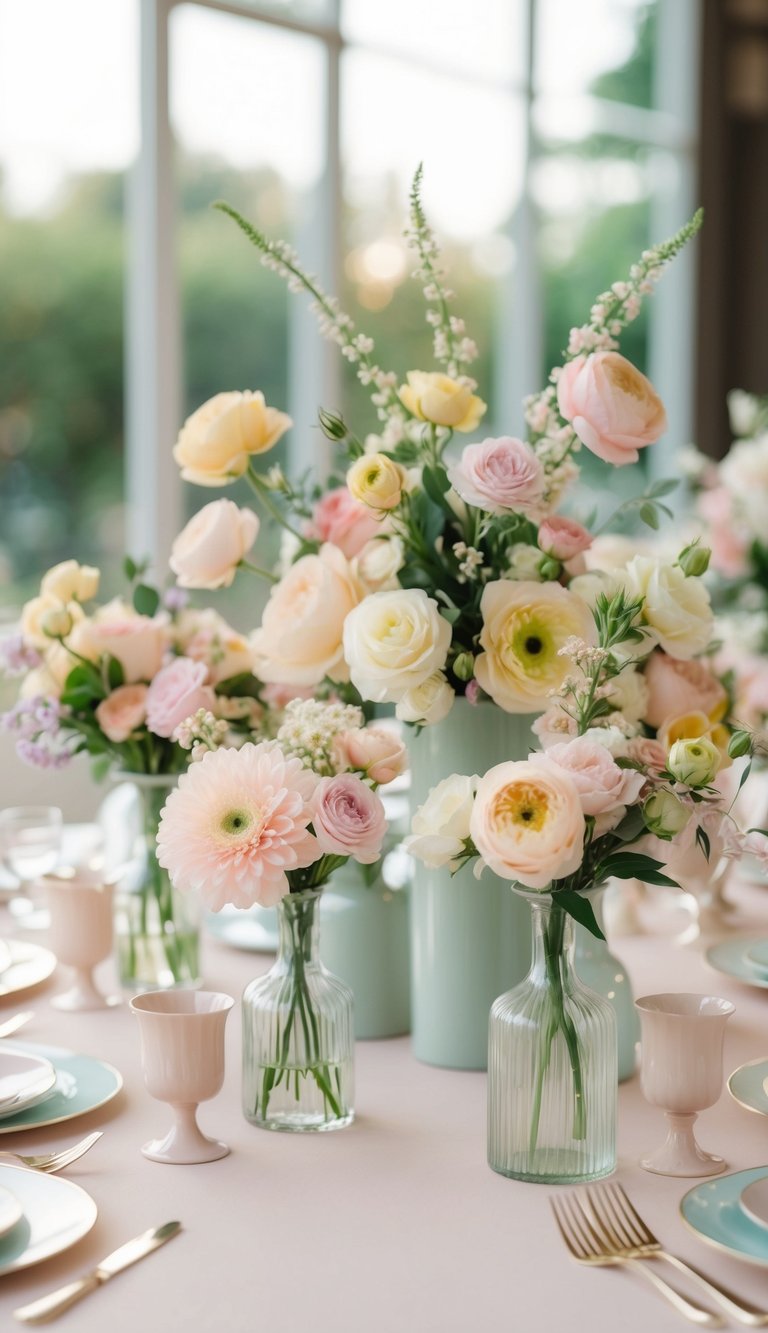10 Purple Flower Bouquet Ideas for Spring
Purple flowers add a touch of elegance and mystique to any bouquet. Whether you’re planning a wedding, special event, or just want to brighten someone’s day, purple blooms offer versatility and visual impact that few other colors can match.
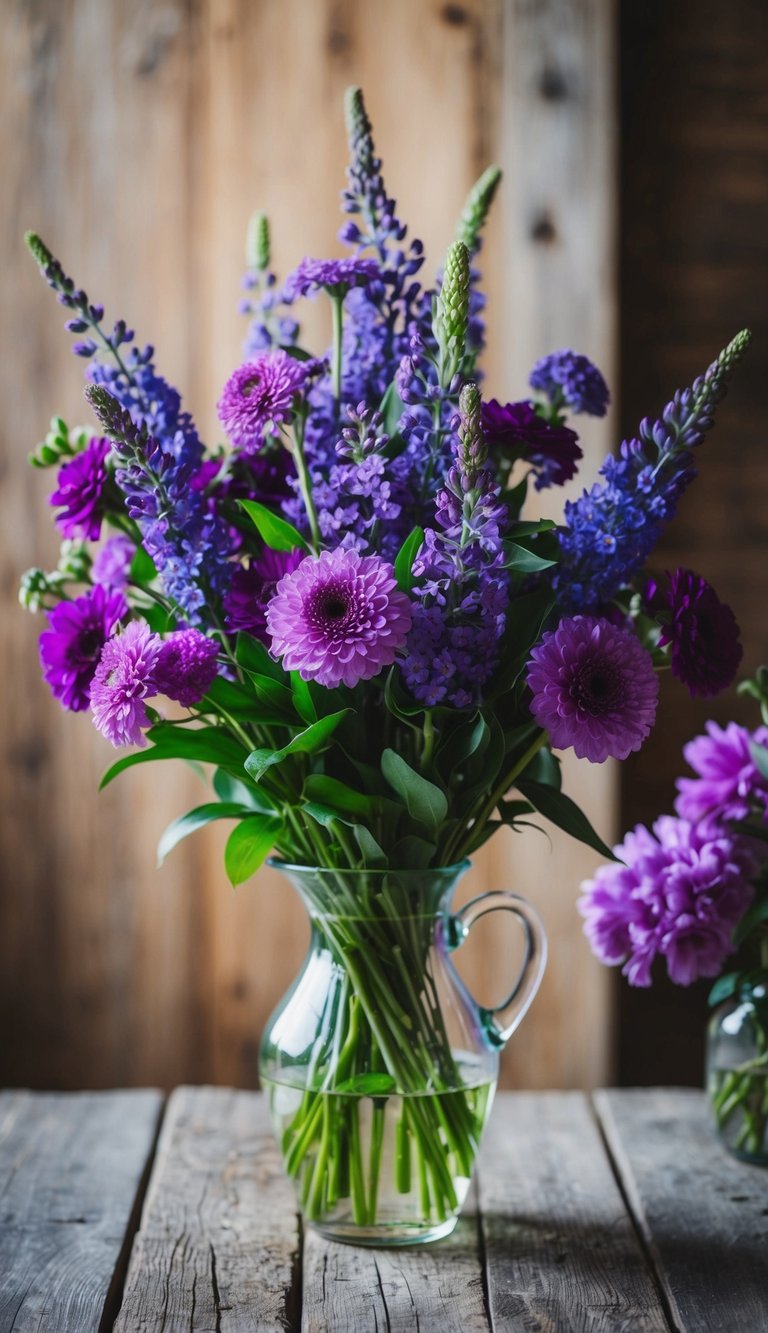
You can create stunning purple flower arrangements using various shades from soft lavender to deep plum, mixing and matching different flower varieties for texture and depth. Purple pairs beautifully with complementary colors like white, yellow, or green accents, allowing you to customize your bouquet to suit any occasion or personal preference.
1. Lilac Cascade Arrangement
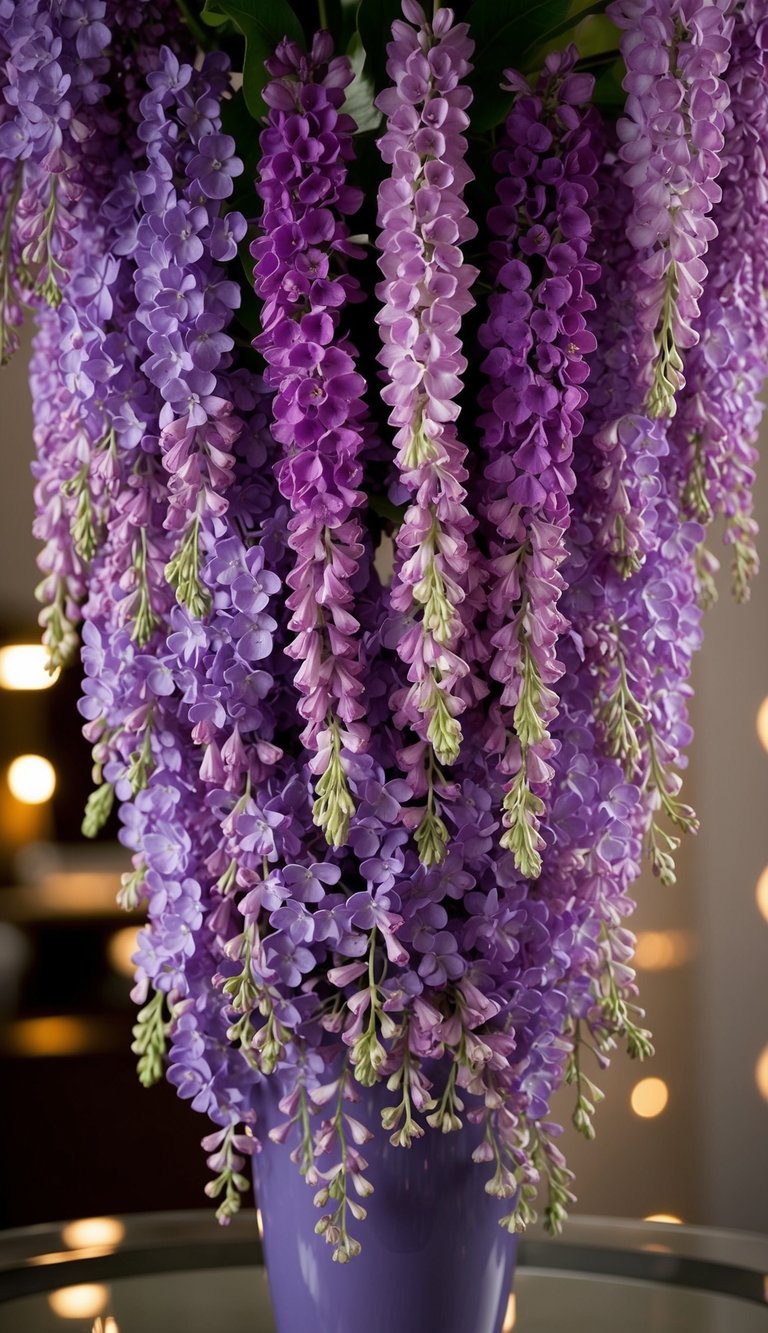
Lilac blooms create a stunning focal point in any purple flower arrangement. You can start with a base of fresh lilac stems varying in shade from pale lavender to deep violet for a dimensional look.
Try pairing your lilacs with cascading purple clematis for a dramatic waterfall effect. The trailing vines add movement and an ethereal quality that makes your bouquet stand out.
For texture, you might add some purple lisianthus and delicate sprigs of lavender. These complementary blooms enhance the lilac’s natural beauty without competing for attention.
Don’t forget to include some greenery like eucalyptus or fern fronds. They provide the perfect backdrop to make your purple blooms pop while adding a fresh, natural element.
When arranging, place taller lilac stems in the center and allow shorter blooms to cascade down the sides. This creates the signature waterfall look that makes this arrangement so special.
A clear glass vase works wonderfully for this arrangement, letting the stems show through as part of the design. You can also try a vintage purple-tinted container for extra charm.
2. Lavender and Orchid Mix
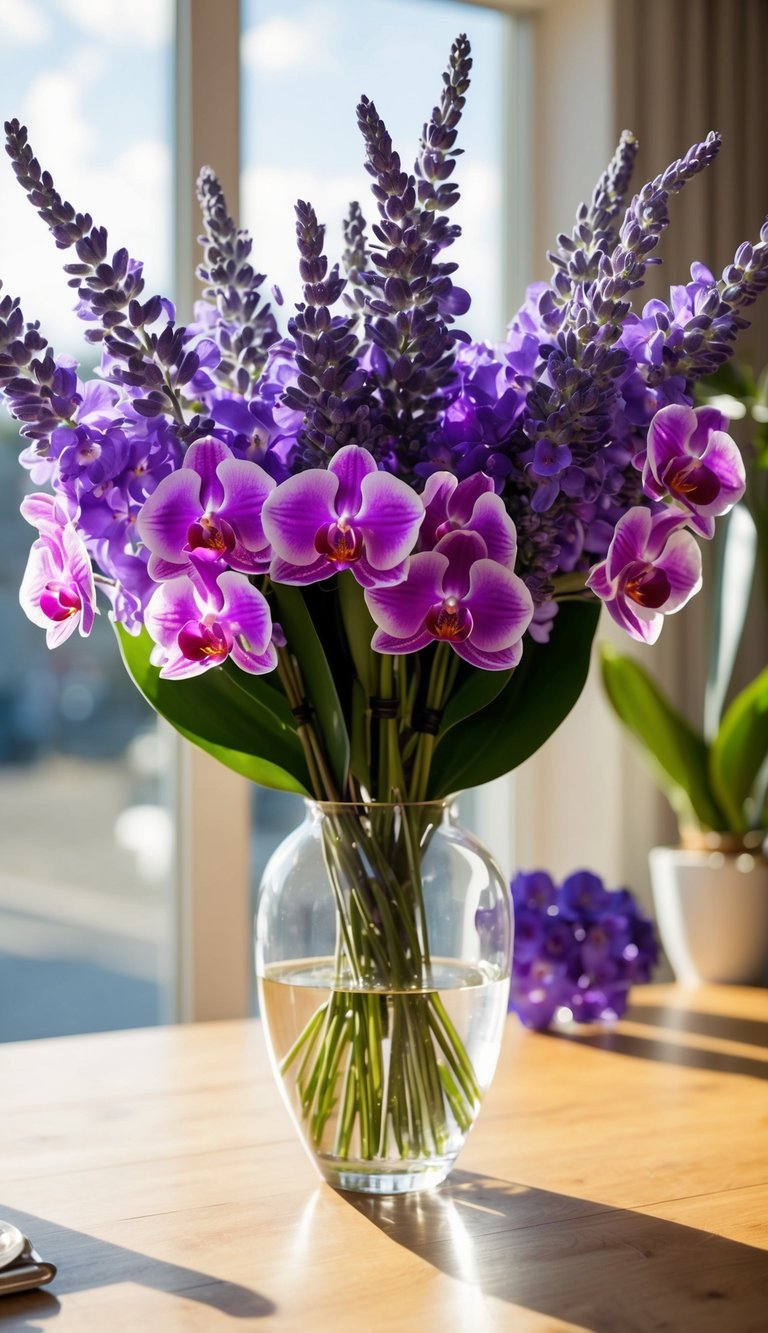
Lavender and orchids create a stunning purple bouquet that balances rustic charm with elegant sophistication. The soft purple hues of lavender stems provide a fragrant base, while orchids add a touch of luxury with their bold shapes and deeper purple tones.
You can enhance this combination by incorporating different orchid varieties like Phalaenopsis or Dendrobium for texture variation. The contrast between lavender’s small clustered blooms and orchids’ dramatic flowers creates visual interest that draws the eye.
For a more cohesive look, try adding white or cream-colored flowers as accents. Baby’s breath or white roses work beautifully to break up the purple palette without diminishing its impact.
This arrangement works wonderfully for spring and summer events, particularly for garden parties or outdoor weddings. The lavender adds a delightful fragrance that will make your bouquet memorable for more than just its appearance.
Don’t forget to wrap your bouquet with a simple ribbon in silver or sage green to complement the purple flowers. You can also add eucalyptus or dusty miller for a touch of silvery-green foliage that pairs beautifully with the purple blooms.
3. Soft Violet Peonies

Soft violet peonies add a dreamy touch to any purple flower arrangement. These delicate blooms offer a lighter shade that beautifully complements deeper purples in your bouquet. Their lush, full appearance makes them perfect as a focal point.
When selecting violet peonies, look for ones with a lavender-blue undertone rather than pink-leaning varieties. This ensures they truly contribute to your purple theme rather than shifting toward a pink palette. You can find these special varieties at specialty florists or farmers’ markets during late spring.
Pair your soft violet peonies with darker flowers like purple lisianthus or deep plum dahlias for a striking contrast. The varying shades create depth and visual interest in your arrangement.
For a simpler look, consider a bouquet made entirely of these violet beauties. Their ruffled petals create enough texture and dimension on their own. Add some eucalyptus or dusty miller for a touch of silvery foliage that enhances the purple tones.
Remember that peonies are seasonal blooms available primarily in late spring and early summer. Plan accordingly if you’re designing for a specific event or occasion that falls outside peony season.
4. Purple Tulip Ensemble
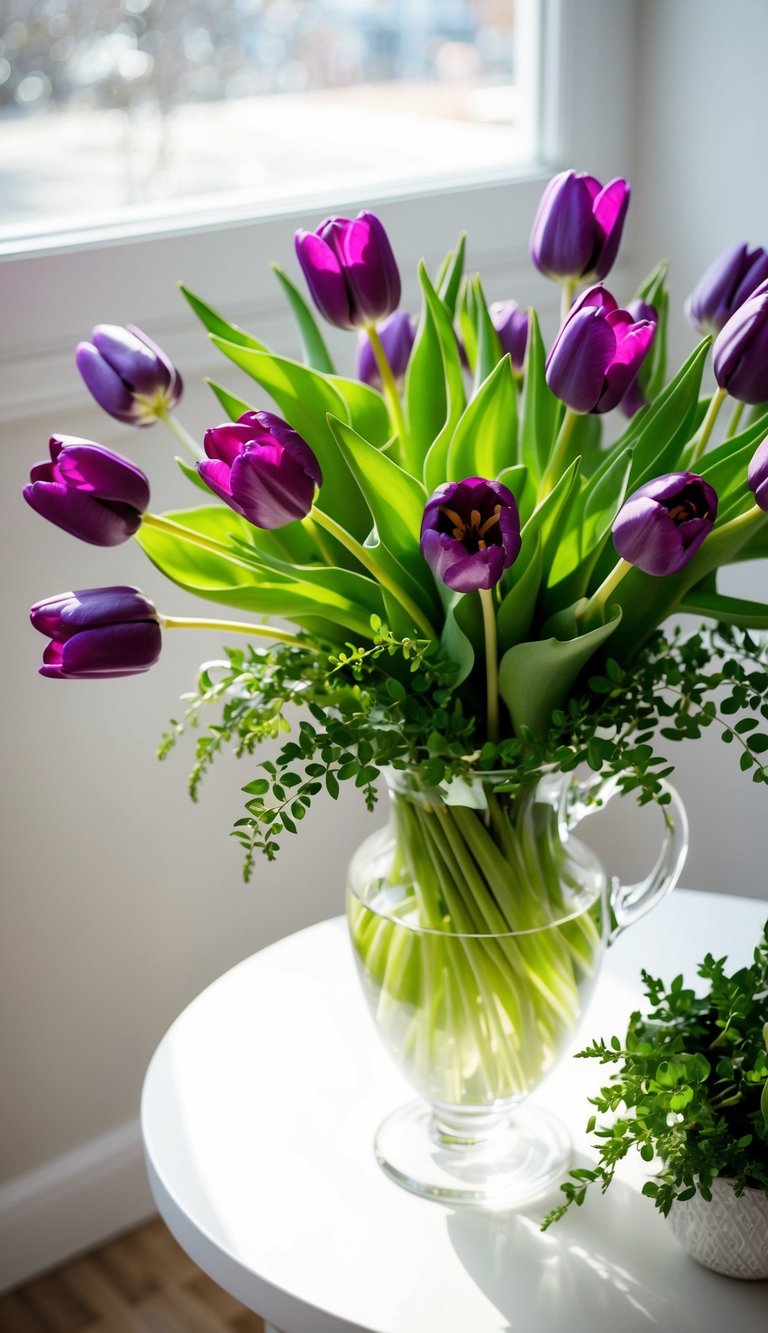
Purple tulips create a stunning bouquet that’s both elegant and modern. Whether you choose deep purple or light lavender varieties, these flowers bring a sophisticated touch to any arrangement.
You can create a monochromatic look using different shades of purple tulips for depth and dimension. Try combining royal purple, lavender, and lilac tulips for a visually interesting yet cohesive design.
For added texture, consider pairing your purple tulips with white accent flowers like baby’s breath or lily of the valley. This contrast will make the purple colors pop even more dramatically.
Tulips have the unique ability to continue growing after being cut, so arrange them slightly shorter than you might with other flowers. You’ll be surprised how they adjust and settle into their perfect positions over a day or two.
For a rustic touch, wrap your purple tulip bouquet with natural twine or a burlap ribbon. Or for something more contemporary, try a sleek satin ribbon in complementary lavender or contrasting silver.
Purple tulips also work beautifully with greenery like eucalyptus or fern fronds. The green and purple combination creates a fresh, vibrant look perfect for spring celebrations.
5. Amethyst Anemone Bouquet

Anemones with their deep purple petals create a stunning focal point for an amethyst-inspired bouquet. You can pair these dramatic flowers with lighter lavender roses for a beautiful contrast that catches the eye.
Consider adding some silver-green eucalyptus or dusty miller foliage to complement the purple tones. These cooler-toned greens enhance the violet shades without competing with them.
Purple anemones symbolize anticipation and protection, making them meaningful additions to your special occasion bouquet. Their dark centers create a striking visual element that draws attention.
For a fuller arrangement, mix in some purple lisianthus or campanula. These supporting flowers add texture while maintaining your purple color scheme.
You might want to wrap your amethyst anemone bouquet with a simple ivory ribbon for an elegant finish. The neutral wrapping lets the vibrant purple flowers take center stage.
This bouquet works beautifully for fall and winter events when deep, rich colors are particularly appropriate. You’ll find it photographs wonderfully, with the deep purples creating a sophisticated and memorable impression.
6. Iris and Hydrangea Blend

Pairing irises with hydrangeas creates a stunning purple bouquet that balances structure with softness. The tall, elegant irises provide height and drama while the fluffy hydrangea blooms add volume and a romantic touch.
You can choose from deep purple iris varieties like ‘Superstition’ or lighter lavender options such as ‘Silverado’ depending on your color preference. For hydrangeas, purple varieties like ‘Endless Summer’ or ‘Purple Passion’ blend beautifully with irises.
This combination works wonderfully for spring and summer arrangements. The contrasting textures make for an interesting visual display that catches the eye without being overwhelming.
Try adding some greenery like eucalyptus or fern fronds to enhance the purple blooms. The silver-green foliage creates a lovely backdrop that makes the purple colors pop even more.
For a more dramatic look, you might include a few stems of white flowers like lisianthus or baby’s breath. The white accents create striking contrast against the purple palette.
7. Wisteria Wonders Vase
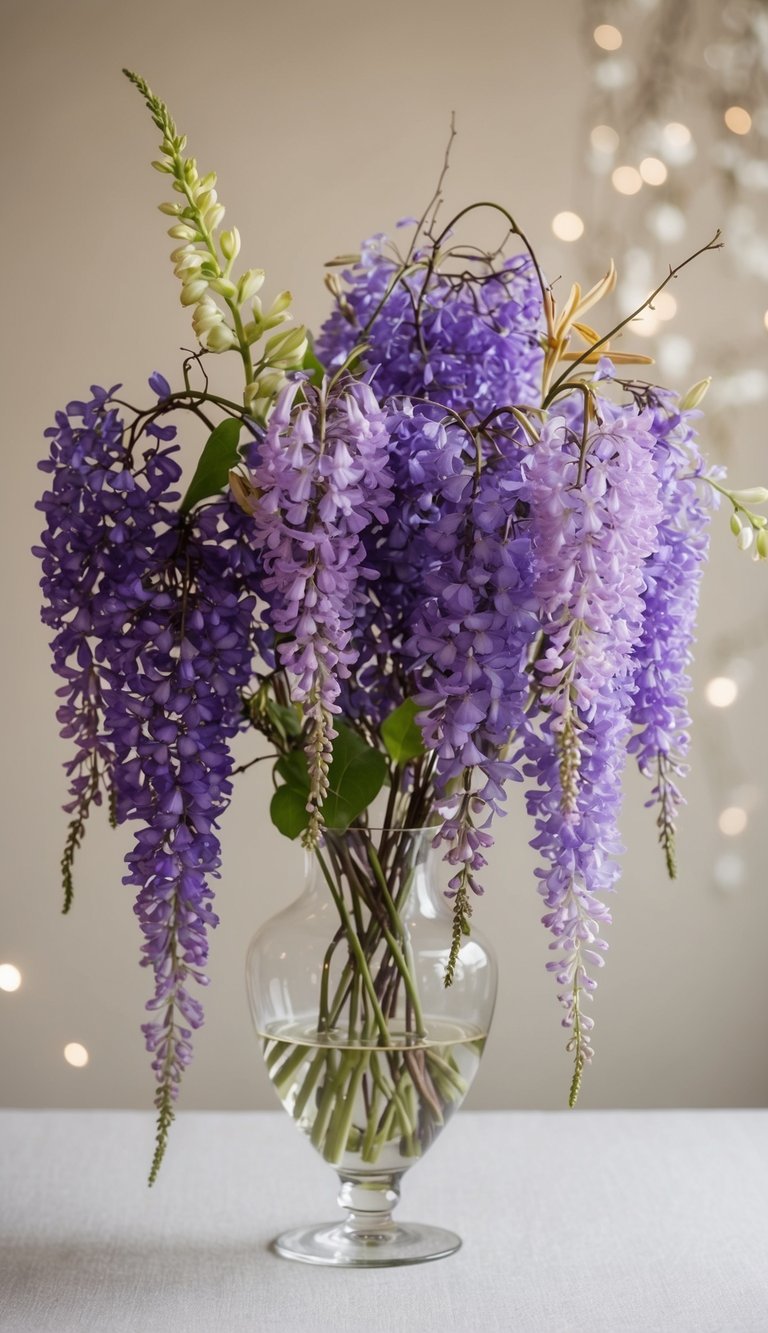
Wisteria brings a touch of whimsical charm to any purple flower arrangement. You can create a stunning focal point by placing cascading wisteria in a tall, slender vase that showcases its naturally draping form.
For best results, pair wisteria with complementary purple blooms like lavender and violets. The varying shades create a beautiful gradient effect that catches the eye from across the room.
When arranging your wisteria vase, remember that less is more. The delicate clusters already provide plenty of visual interest, so you don’t need to overcrowd your arrangement.
Choose a glass vase to show off the woody stems, which add an organic element to your display. Clear vessels also allow you to see the water level easily, ensuring your wisteria stays fresh longer.
You can place your Wisteria Wonders vase on a mantel or as a dining table centerpiece. The soft purple tones create a relaxing atmosphere perfect for dinner parties or quiet evenings at home.
Change the water every two days to keep your wisteria looking fresh. A tiny bit of flower food in the water will help extend the life of your beautiful purple arrangement.
8. Royal Purple Rose Grouping

Royal purple roses bring a touch of luxury to any flower arrangement. These stunning blooms create an air of elegance that’s hard to match with other flowers. You can easily build a gorgeous monochromatic bouquet using different shades of purple roses.
Try pairing dark purple roses with lavender roses for a beautiful gradient effect. This combination creates visual interest while maintaining the regal purple theme. Add some greenery like eucalyptus or fern for contrast.
For a more dramatic look, you can arrange just deep purple roses in a tight, dome-shaped bouquet. This classic style is perfect for formal events or as a sophisticated gift. The rich color makes a bold statement without needing additional flowers.
You might also consider mixing purple roses with white flowers for a striking contrast. White lilies or baby’s breath can brighten the arrangement while letting the purple roses remain the focal point.
Don’t forget that vase choice matters too. Crystal or silver vases complement the royal purple theme beautifully. A simple clear glass vase also works well by letting the flowers speak for themselves.
9. Plum-Petal Pansies
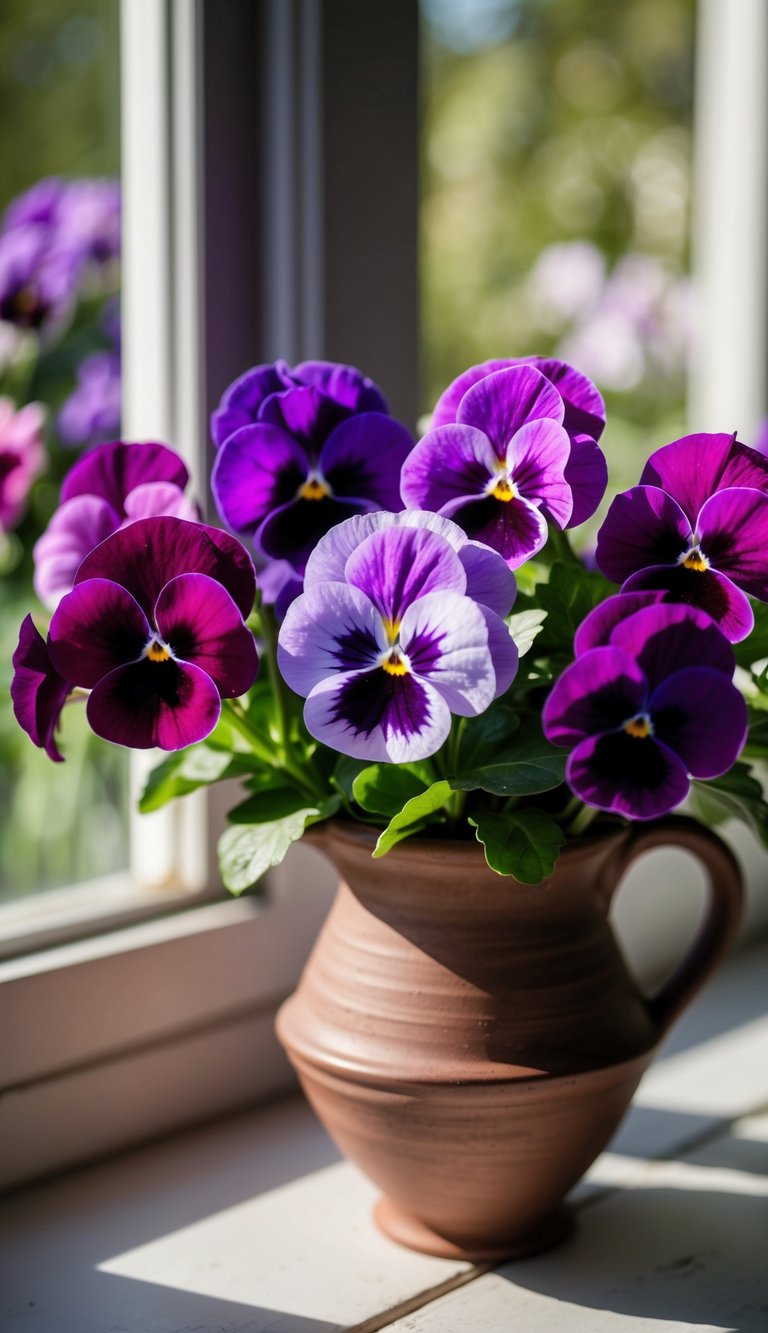
Plum-petal pansies offer a striking purple addition to any bouquet with their velvety petals and deep, rich coloration. These charming flowers come in various shades from light lavender to deep eggplant, allowing you to create dimension in your purple arrangements.
When selecting pansies for your bouquet, look for ones with the deepest plum tones if you want a dramatic effect. Their distinctive “face” markings add personality and visual interest to even the simplest arrangements.
You can pair plum pansies with lighter purple blooms like lavender or lilac for a tonal purple bouquet. Their compact size makes them perfect as accent flowers that fill spaces between larger blooms.
For a rustic touch, consider combining them with dried lavender and purple statice. The textural contrast between the smooth pansy petals and other elements creates a visually appealing arrangement.
Pansies also work beautifully in small, delicate arrangements for bedside tables or bathroom counters. Their subtle sweet fragrance adds another sensory element to your purple bouquet experience.
10. Heather and Hyacinth Cluster
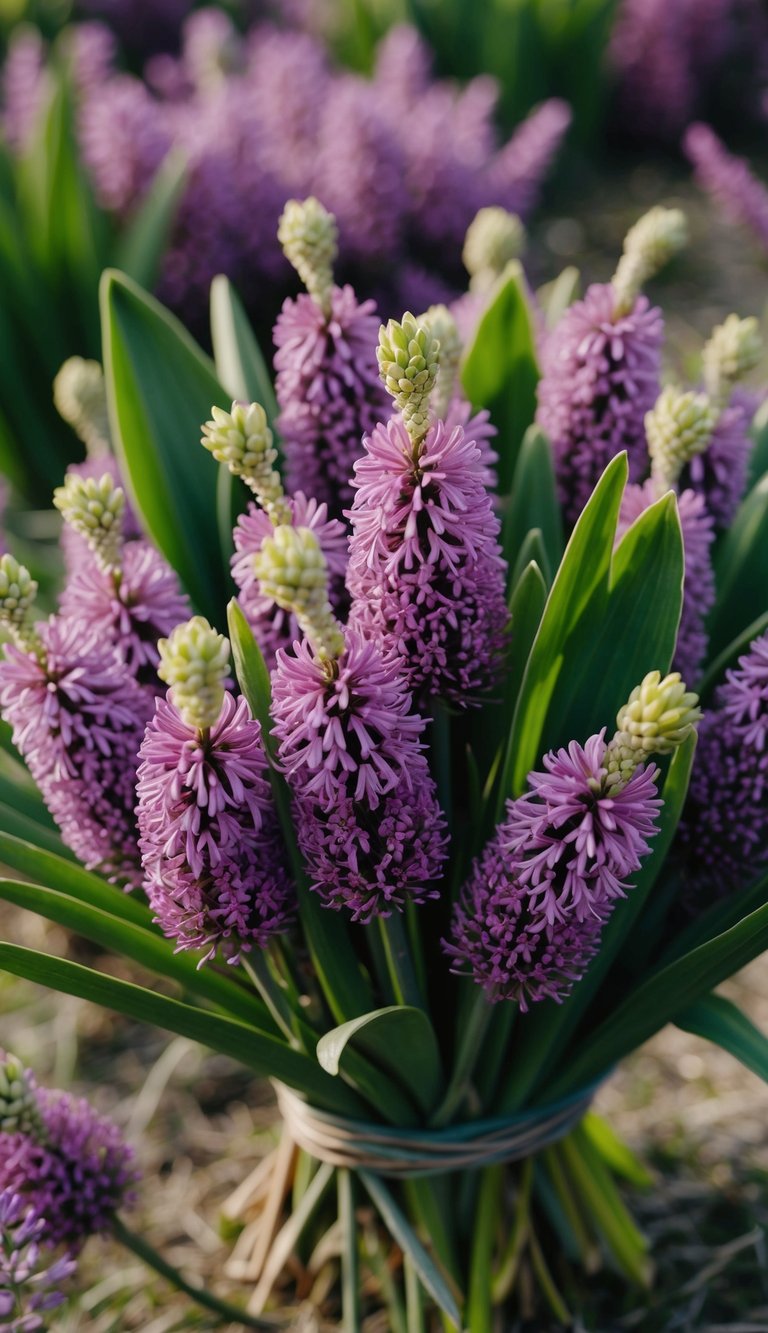
A heather and hyacinth cluster creates a charming purple bouquet that brings together different textures and purple tones. The delicate, bell-shaped hyacinths provide stunning color and an intoxicating fragrance that can fill a room.
Pair deep purple hyacinths with soft lavender heather for a beautiful contrast. The tiny clustered blooms of heather add a wispy, ethereal quality that softens the more structured hyacinth stems.
You can arrange these flowers in a simple glass vase for a modern look. For a more rustic appearance, try wrapping the stems in twine and placing them in a mason jar or ceramic container.
These flowers work well with greenery like eucalyptus or fern fronds. The green accents help the purple tones pop even more dramatically.
Consider adding white accents like baby’s breath or white heather varieties if you want to brighten the arrangement. This combination is perfect for spring celebrations or as a thoughtful housewarming gift.
Choosing the Right Shades of Purple
Purple flowers come in a stunning range of tones from delicate lavender to deep aubergine. Selecting the perfect shade can transform your bouquet from ordinary to extraordinary, especially when you understand which purples work best together.
Understanding Different Purple Tones
Purple flowers span the spectrum from cool to warm tones. Cool purples lean toward blue and include lavender, periwinkle, and violet. These create serene, calming arrangements perfect for bedrooms or peaceful spaces.
Warm purples contain more red undertones, like magenta, orchid, and plum. These shades add energy and drama to your bouquet, making them ideal for celebratory occasions.
Light and dark purples work beautifully together in the same arrangement. Try pairing pale lavender with deep eggplant for striking contrast.
Consider your room’s lighting when selecting purple shades. Natural light showcases true purple tones, while artificial lighting might make some purples appear more blue or red than they actually are.
Popular Purple Flower Varieties
Lavender offers a soft, pale purple with a distinctive fragrance. It’s perfect for relaxing bouquets and adds a wonderful scent to any arrangement you create.
Allium blooms feature spherical flower heads in vibrant purple. These architectural flowers add unique texture and a playful element to your bouquets.
Purple roses range from lilac to deep violet and bring classic elegance to any arrangement. You’ll find them available year-round at most florists.
Other stunning options include:
- Lisianthus: Delicate, rose-like blooms
- Iris: Bold, structural flowers
- Hydrangea: Large, clustered blooms that make a statement
For the most striking bouquets, mix different purple varieties with varying heights, textures, and shapes. This creates depth and visual interest in your arrangement.
Mixing Purple with Other Colors
Purple flowers create stunning visual impact when paired with other hues in a bouquet. Color combinations can evoke different moods and complement various occasions, from romantic celebrations to elegant dinner parties.
Complementary Color Pairings
Purple and yellow create a dynamic duo that catches the eye immediately. Try pairing purple irises or lisianthus with bright sunflowers or yellow roses for a cheerful arrangement that pops.
White works wonderfully with purple for elegant, sophisticated bouquets. Crisp white roses or lilies alongside lavender sprigs or violet dahlias create a timeless look perfect for weddings.
Green foliage isn’t just filler—it’s an essential companion to purple blooms. Eucalyptus, ferns, or dusty miller provide texture and a natural backdrop that makes purples appear more vibrant.
For bold statements, combine purple with orange or coral flowers. This unexpected pairing creates energy and warmth, ideal for summer celebrations or when you want to make a dramatic impression.
Creating a Balanced Bouquet
Size matters when mixing colors with purple. Use the 60-30-10 rule: 60% dominant color (purple), 30% secondary color, and 10% accent color for a visually pleasing arrangement.
Consider the intensity of your purple flowers. Deep plums and eggplants need bright counterpoints like cream or pale pink, while lighter lavenders blend beautifully with soft blues or peaches.
Texture variety keeps purple bouquets interesting. Mix velvety purple anemones with spiky alliums or fluffy hydrangeas with structured calla lilies for dimensional appeal.
Remember to vary stem lengths when arranging. Place taller purple delphinium or larkspur in the center or back, with shorter blooms like violets or purple tulips toward the edges for a professional look.

